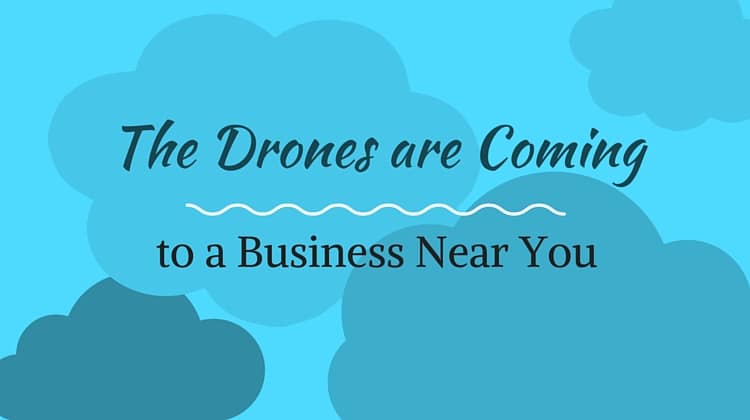
Twenty years ago we would have never imagined the possibility of using drones in private business since their only access and application were black ops military uses and CIA observations. As technology evolves, however, so does man’s imagination and application of such technology.
Someone once said that necessity is the mother of invention, and I think in the drone’s case it was more about convenience. The FAA estimates by the year 2020 there will be 7 million drones in the airways and 2.7 million of these will be commercial.
Small business owners are looking carefully at how drones can help them do more business more efficiently, more creatively, and more dynamically. The possibilities for using drones are huge, but there are a number of factors to consider if you’re thinking about employing this new technology. They are centered around safety and liability.
Drones, sometimes called unmanned aircraft systems (UAS), are quickly demonstrating their usefulness for tasks that are inefficient or dangerous for humans. These small, remote controlled vehicles can deliver packages and take pictures, even in places that are remote or inaccessible. At their best, they are a useful tool or an engaging toy. At their worst, they can be a liability nightmare. They can help us reach heights of observation or they cause us to reach the depths of despair.
Here are some things to know if you’re considering using drones in your business:
Drone Regulations
Regulators are struggling to keep up with the popularity of drones. The Federal Aviation Administration (FAA) has jurisdiction over drones, and they have recently issued new regulations regarding the commercial use of drones. A final ruling on regulations is still outstanding, so drone operators should monitor the progress of this ruling to ensure they are in compliance with any changes.
Currently, any drone weighing more than 0.55 lbs. and less than 55 lbs. must be registered with the FAA before it can be flown outside. In order to use a drone for commercial purposes, you must obtain a Section 333 exemption for civil operations. These exemptions are in high demand right now as more and more businesses are applying to be able to use drones, so there is a considerable wait time to get an exemption. You must also have a Certificate of Waiver or Authorization (COA). The drone pilot must have an FAA airman certificate.
The difference between drones and other vehicles is that drones can be operated outside the line of sight of the operator. Regulations address this, but they are difficult to enforce. If drones are to realize their full potential, operators will need to be able to use them without being able to see them. The regulations around operating drones outside the operator’s line of sight will need to be developed and enforced.
What about Risk?
There’s no doubt that operating a drone involves significant risk. The drone could crash, causing an injury or damaging someone’s property. The possibility of a drone causing a larger aircraft to crash is a big concern.
Another issue that may be even more concerning is privacy. The use of drones to take photographs and video has already generated lawsuits and the number and scope of these suits will only increase. Drone operators can be sued for taking unauthorized photos, video, and audio, even if the recording is not intentional.
It’s critical to protect yourself against these risks when using drones. Any efficiencies you gain from using drones could be quickly wiped out by a single claim or suit from misuse or damage.
Who is Liable?
Liability for drone accidents and misuse could be ascribed to the drone’s manufacturer, owner, lessee or operator, or all of these entities. It’s critical to carefully review your business liability insurance coverage to see if drones are covered. If they are not specifically named in the policy, you are probably not covered in the event of property damage or bodily injury caused by a drone you own or operate.
Drone manufacturers should have directors’ and officers’ coverage to protect them in terms of compliance with changing regulations. Renting or leasing drones to customers will require specialized coverage along with indemnity language in the rental agreement.
A smart strategy would include coverage specifically for invasion of privacy claims, including trespassing, stalking, spying, and harassment. These claims could be brought against the drone’s manufacturer, provider, or operator, so all should be covered.
It’s exciting to consider how drones could make your business more efficient and more profitable and to think that these vehicles will someday be commonplace. In the meantime, make sure you are in compliance with current regulations and protected from liability if you decide to use a drone.
About The Author
Gyawu Mahama is Social Media and Marketing Manager at Hiscox Small Business Insurance. In this role Gyawu is responsible for driving social media engagement, publishing Hiscox’s award winning small business blog, and internal communications. Follow Gyawu at @GyawuTweets.